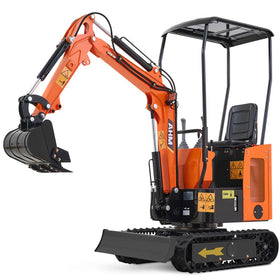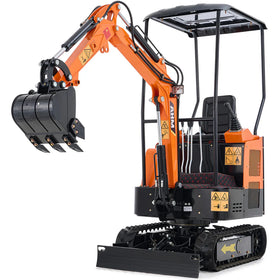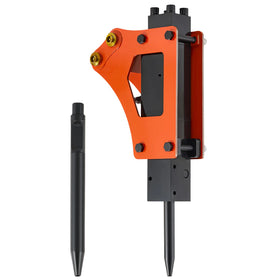A mini excavator and a skid steer loader are similar in many ways, and both can be used for a variety of similar tasks. But with construction and landscaping projects getting more complex and job sites getting tighter, you need to know exactly what each machine can and can't do.
Understanding which tasks are best suited for a mini excavator and which are better handled by a skid steer loader can help you work more efficiently, saving both time and money
This isn't just about picking the cheaper option or going with what looks cooler. The wrong choice can cost you time, money, and serious headaches on the job site.

Whether you're a contractor building your fleet or a homeowner tackling a major project, understanding these differences will save you from making expensive mistakes.
Let's break down when each machine shines and when you'd be better off with the other option.
When to Choose a Mini Excavator
Mini excavators have become the go-to choice when precision digging is your primary need. So, if your project (s) involve a lot of precision digging, it is wise to choose a mini excavator over a skid steer.
First, mini excavators are primarily designed for moving and working with earth. These track-mounted powerhouses are built for one thing above all else: moving earth with surgical precision.
Second, the tracked design and hydraulic arm system of mini excavators provide unmatched stability and control for detailed work. With the multitude of mini excavator attachments available, you can get even better precision and increased digging capacity.
When it comes to digging projects, you may not be able to replicate the same stability or precision with a skid steer.
For any of the following projects, choose a mini excavator:
- Deep trenching - Most can dig 6-9 feet deep with pinpoint accuracy
- Utility line installation - Narrow, precise trenches without damaging existing infrastructure
- Foundation work - Exact depths and clean edges to pour concrete
- Pool excavation - Complex shapes and precise grading
- Landscaping projects - Creating water features, retaining walls, and terraced areas
- Working in tight spaces - 360-degree rotation means no repositioning
Related: How to dig a pool with a mini-excavator.
Mini Excavators are Built for Precision Tasks.
Consider the AHM AX-17, for example, with its 89-inch dig depth and swing boom capability exemplifies this precision approach.

At 3,651 lbs operating weight, it provides the stability needed for deep, accurate excavation while its 23 HP B&S engine delivers consistent hydraulic power.
The swing boom feature allows operators to dig at multiple angles without repositioning the entire machine, making it perfect for complex trenching and utility work where precision matters more than speed.
When to Choose a Skid Steer
Choose a skid steer loader over a mini excavator if your task or project requires a degree of versatility (as opposed to precision). If you need one machine that can handle multiple tasks throughout the day, this is your answer. For any given project, there are usually more than 10 creative ways to use a skid steer loader.
It’s safe to say that skid steers are the Swiss Army knives of construction equipment: they can handle a variety of projects. Many people even use mini skid steers for snow removal.
For any of the following tasks, you can choose a skid steer:
- Handling materials - Loading, moving, and stacking with speed
- Site cleanup - Debris removal and general hauling
- Grading and leveling - Fast, accurate surface preparation
- Snow removal - Specialized attachments for winter maintenance
- Agricultural work - Feed handling, stall cleaning, general farm tasks
- Light demolition - Breaking up small structures and cleanup
Why Skid Steers Are More Suitable for Versatile Operations.
The wheeled design and universal attachment system make skid steers incredibly adaptable for changing job requirements.
The AHM SS-38 with its 23 HP Briggs & Stratton engine and 827 lb lift capacity demonstrates this versatility perfectly. At just 45.3 inches wide and 1,733 lbs, it can navigate tight spaces while handling 30-degree inclines with ease.
The quick-change attachment system works with everything from buckets to grapples to augers, and the 3.7 mph travel speed means you can reposition quickly between tasks.
With up to 7 hours of operation on a single 20L fuel tank, it keeps working while keeping costs down.
When to Choose a Mini Excavator Over a Skid Steer
The mini excavator vs mini skid steer decision often comes down to the type of ground you're working on and how deep you need to dig.
Choose the mini excavator when:
- Working on soft or uneven terrain - Tracks distribute weight better and provide superior traction
- Deep digging is required - Need to go beyond 3-4 feet consistently
- Precision is critical - Utility work, foundation prep, or complex landscaping
- Working around obstacles - 360-degree rotation eliminates repositioning
- Wet or muddy conditions - Tracks won't get stuck like wheels
- Limited access points - Can work in one spot and reach multiple areas
Why do Mini Excavator Tracks Beat Skid Steer Wheels on Difficult Terrain?
Track-driven mini excavators provide superior stability and traction on challenging surfaces where wheeled equipment struggles. The AHM AY-25 shows this advantage with its 5,401 lb operating weight distributed across wide tracks, providing excellent ground pressure distribution.
Its 25 HP Perkins diesel engine maintains consistent power even on slopes, while the zero tail swing design lets you work tight against walls or obstacles.
The 108.3-inch dig depth capability means you can complete deep utility trenching or pool excavation jobs that would require multiple machines with a skid steer.
When to Choose a Skid Steer Over a Mini Excavator
The mini skid steer vs mini excavator choice often favors the skid steer when speed and versatility matter more than digging depth.
Choose the skid steer when:
- Multiple tasks per day - Need to switch between digging, loading, and hauling
- Paved surfaces - Wheels won't damage concrete or asphalt
- Speed is important - Can travel faster between work areas
- Multiple attachments are needed - There are over 1,000 different skid steer loader attachments available
- Budget is tight - Lower purchase price and operating costs
- Indoor work - Compact size and wheel mobility for warehouse projects
- Transporting materials - Better for moving bulk materials efficiently
Why Are Skid Steer Wheels and Attachments More Versatile Than Mini Excavator Wheels and Attachments?
The wheeled design and universal attachment system make skid steers unmatched for multi-task operations, where efficiency across different jobs matters more than specialized digging capability.
The AHM SS-38's compact 45.3-inch width and quick-change attachment system mean you can switch from trenching with an auger to material handling with a bucket to cleanup with a grapple in minutes, not hours.
The 3.7 mph travel speed and joystick controls make repositioning fast and precise, while the 30-degree climbing ability handles most job site conditions without the ground pressure concerns of tracked equipment.
The Bottom Line: Which Machine Should You Choose?
| Task | Mini Excavator or Skid Steer? | Notes |
| Working on soft or uneven terrain | Mini Excavator | Tracks provide better traction and weight distribution |
| Deep digging (beyond 3–4 feet) | Mini Excavator | Better for utility work, foundations, or precision landscaping |
| Precision work | Mini Excavator | 360° rotation for tight spots; good for detailed excavation |
| Wet or muddy conditions | Mini Excavator | Tracks don’t get stuck as easily as wheels |
| Limited access points | Mini Excavator | Can sit in one place and reach several areas |
| Multiple tasks per day | Skid Steer | Easily switches between digging, loading, and hauling |
| Working on paved surfaces | Skid Steer | Wheels are gentler on asphalt and concrete |
| Needing to move quickly | Skid Steer | Faster travel speed between job sites |
| Using multiple attachments | Skid Steer | Over 1,000 attachment options available |
| Budget-conscious projects | Skid Steer | Lower purchase price and cheaper to operate |
| Indoor or warehouse work | Skid Steer | Compact and wheel-based for tight, flat indoor areas |
| Transporting bulk materials | Skid Steer | Better for efficient loading and moving |
The mini excavator vs skid steer debate isn't about finding the "better" machine - it's about matching capabilities to your specific needs.
The reality for most people? You'll eventually want both. Many successful contractors start with one machine based on their primary work, then add the other as their business grows. You’ll find the perfect answer to the skid steer vs mini excavator debate once you realize they're complementary tools, not competing alternatives.
Whether you choose the precision digging capability of an AHM mini excavator or the versatile efficiency of an AHM skid steer, you're investing in equipment that'll handle the jobs that matter to your operation.
The key is being honest about what you actually need to accomplish, not what looks impressive in the equipment yard.
Here’s a complete guide on how to determine what size mini excavator you need. If you settle on a skid steer, here’s another guide detailing how to operate a skid steer.







